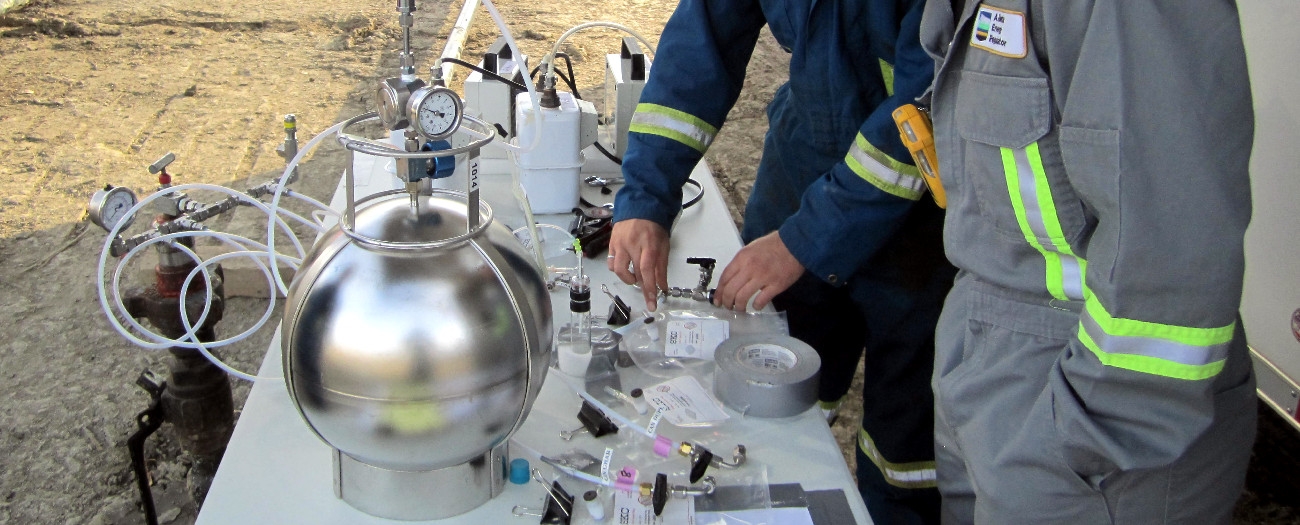Study seeks answers about fracking-related emissions
Alberta - December 05, 2016Sporting grey coveralls and a hard hat, Mike Brown has traded in his paper-pushing desk job for the cold and unknown. This is one of many days (and nights) that he and other Alberta Energy Regulator (AER) staff will be at newly drilled wells to answer one question—what’s in the flare?
The AER and Alberta Health are leading a study to discover what gases are produced during the “flowback” phase of hydraulic fracturing operations, whether concentration levels exceed Alberta’s air quality and health thresholds, and whether there are any potential risks to human health and the environment.
“We’re trying to figure out the science behind what’s in a flare, and the first step is to find out if the fluids used for hydraulic fracturing even release gas to the flare stack during flowback,” says Brown, an oil and gas advisor and engineer by trade.
“Flowback” refers to the process whereby fluids used to fracture a well are pumped back to the surface after hydraulic fracturing is complete. The fluids, and any oil and gas from the well, are then sent to a separator to separate liquid from gas; the liquid goes to a tank where it’s disposed of, while the gas is burned in the flare stack.
Searching for answers
Once the AER uncovers this answer, the next question is what happens to the gases? Are they released into the atmosphere? Are they destroyed by the heat of the flare? Or have they transformed into another substance?
The study was prompted by an AER assessment of recurring complaints about hydraulic fracturing activities in the Lochend and Didsbury areas of Alberta. The assessment found a knowledge gap about what emissions are generated by flaring in the first stages of bringing a new well into production.
As part of the quest for answers, the AER is testing eight wells near Drayton Valley and Rocky Mountain House that are drilling into the Cardium geological formation. These wells were chosen because no new development has been planned in Lochend and Didsbury and because they target the same formation as the wells previously drilled in these areas.
To do this, Brown and an integrated team including toxicologist Mandy Dumanski have designed a study to collect gas samples between the separator and the flare stack over the entire flowback period—typically up to 72 hours. These samples are sent to a lab for analysis to identify the composition and concentrations in the gas. The analysis can detect up to 10 000 different compounds – some of which may be present in the emissions produced during flowback operations.
“This type of scan isn’t typical; it’s fairly unique and will help us figure out what chemicals may be present in flowback emissions and could be going to the flare,” says Dumanski.
The AER, university researchers, and Alberta Health will use this information to determine what could happen to those chemicals when burned and ultimately released to the environment.
Like a science fair
While some AER staff regularly visit well sites, this type of work is a first for the regulator and, quite possibly, the industry. For Brown, who’s based in Calgary, the experience harkens back to his days as a summer student—a giddy kid going out to the field for the first time.
And with the odd sampling apparatus displayed on a folding table, Brown jokes that the whole setup resembles something from a science fair—so much so that it piques the interest of the workers onsite.
“You’ve got two of us guys from the AER standing behind the table and we explain what we’re doing, and the guys just love it. They tell us, ‘This is good. I’m glad we’re doing this,’” says Brown.
The AER invited a handful of operators planning to develop new wells in the Cardium formation to participate in the study, not knowing how many would sign on. As it turns out, all were overwhelmingly supportive.
“When we told them about the study, they said to us, ‘if we’re part of the problem, we want to know about it, so let’s figure it out and get the answer.’”
A technical steering committee is providing strategic and operational support and guidance throughout the study. It includes InnoTech Alberta (part of Alberta Innovates), Alberta Health, Alberta Environment and Parks, a public representative from the study area, some of Canada’s top flare researchers from Carleton University, and the AER.
The study is still in its early stages, and once complete, a report will follow. From there the AER will decide what, if any, changes will be made to the regulatory requirements. One thing is for sure – everyone involved is committed to finding answers.
Monica Hermary, Writer


